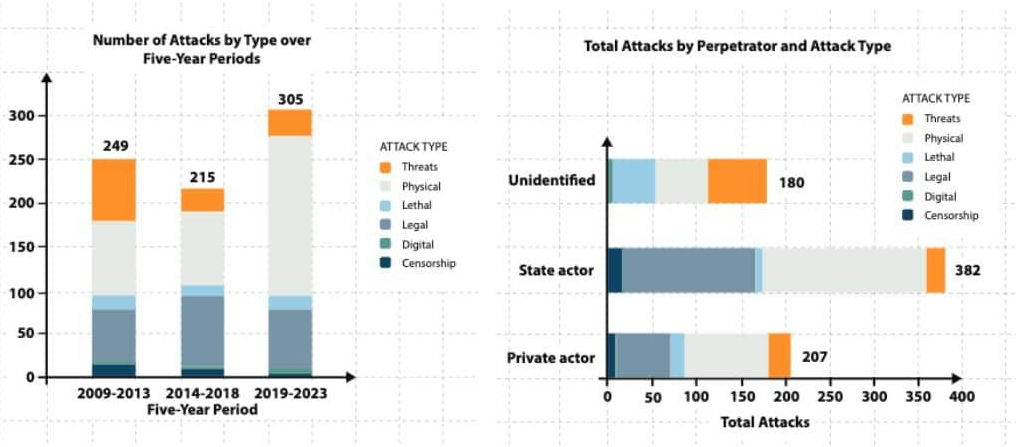Climate and Environment journalists worldwide are facing increasing violence, with as many as 44 journalists killed in last 15 years, according to a new report released by UNESCO on the occasion of World Press Freedom Day on May 3, 2024.
Groundxero | May 3, 2024
The United Nations General Assembly declared May 3 to be World Press Freedom Day to raise awareness of the importance of freedom of the press and remind governments of their duty to respect and uphold the right to freedom of expression as enshrined under Article 19 of the Universal Declaration of Human Rights (1948). The day is celebrated every 3rd of May, with a special theme. The theme for World Press Freedom Day in 2024 is “A Press for the Planet: Journalism in the face of the Environmental Crisis”.
The global environmental crises of climate change, loss of biodiversity and pollution, impact the lives of billions worldwide and environmental journalism plays a key role in how the world understands this. State and private actors, as well as criminal groups, have been known to intimidate, harass, or even physically harm journalists in an effort to silence their reporting.
In its new report Press and Planet in Danger, released by UNESCO on the occasion of World Press Freedom Day on May 3, 2024, revealed instances in which at least 749 journalists and news media outlets reporting on environmental issues were targeted with murder, physical violence, detention and arrest, online harassment or legal attacks in the period 2009-2023.
The report, launched at the 2024 World Press Freedom Day Global Conference in Santiago, Chile from 2-4 May 2024, stresses that the problem is global, with attacks taking place in 89 countries in all regions of the world.
According to the report, environment journalists worldwide are facing increasing violence, with as many as 44 journalists killed in the last 15 years of which only 5 have resulted in convictions – a shocking impunity rate of almost 90%. The killings were highest in Asia and the Pacific with 30 cases, while Latin America and the Caribbean reported 11.
Over 70 per cent of the total 905 journalists and agencies surveyed from 129 countries informed that they had been attacked, threatened or pressured, according to the report. Journalists attacked were mainly reporting topics on environmental protests, mining, land conflict, deforestation, extreme weather events, pollution, the fossil fuel industry and environmental damage. Those covering environmental protests, mining and land conflicts faced the highest number of attacks. The report also found attacks had more than doubled in recent years, rising from 85 in 2014-2018 to 183 between 2019-2023. At least 194 of the attacks took place at environmental protests, with police and military forces behind 89 of them, reveals the report.

Type of attack to environmental journalists and media outlets (left) and perpetrators (right). Image: UNESCO (2024).
In addition to physical attacks, a third of journalists surveyed said they had been censored, and almost half (45%) said they self-censored when covering the environment, due to fear of being attacked, having their sources exposed, or due to an awareness that their stories conflicted with the interests of concerned stakeholders.
The study found that these attacks came from state machinery such as the police, military forces, government officials, employees and local authorities. “Private actors — extractive industry companies, criminal groups, protesters and local communities — were also responsible for the attacks,” it added.
UNESCO Director-General, Audrey Azoulay said, “Without reliable scientific information about the ongoing environmental crisis, we can never hope to overcome it. And yet the journalists we rely on to investigate this subject and ensure information is accessible face unacceptably high risks all over the world, and climate-related disinformation is running rampant on social media. On World Press Freedom Day, we must reaffirm our commitment to defending freedom of expression and protecting journalists worldwide.”
A comprehensive report, Climate and Environmental Journalism Under Fire: Threats to free and independent coverage of climate change and environmental degradation, released by the International Press Institute (IPI) in February (2024), provides an in-depth look at various aspects of this growing crisis. The report also exposes the inherent risks to press freedoms:
“Certain stories – which vary from region to region – are effectively off-limits for journalists due to the dangers associated with covering them. This censorship silences vital public-interest information and endangers the fight to protect the environment and address the climate crisis.”

